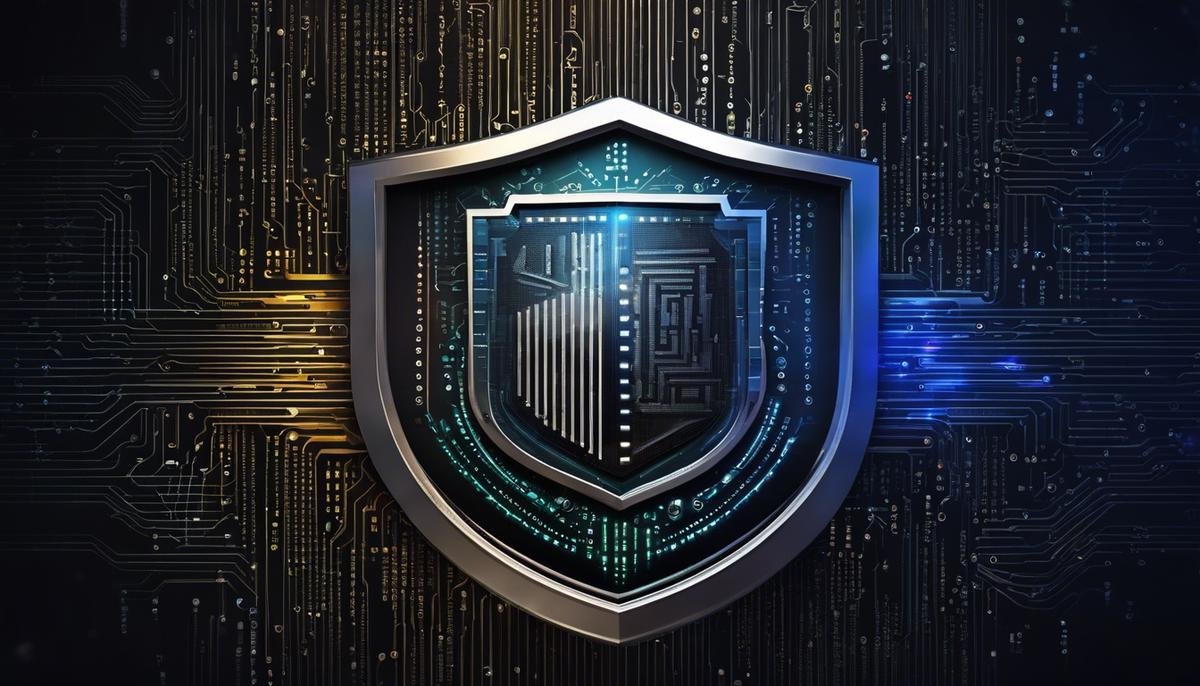In an era that is seeing an exponentially increasing dependence on digitization, understanding the role of Artificial Intelligence (AI) in cybersecurity is more than a mere intellectual exercise – it is crucial to the effective functioning of our digital world. AI, the avant-garde technology that mimics human intelligence, has permeated various sectors, not least of which is cybersecurity. The ability of AI to analyze vast data sets, predict potential security breaches, and respond proactively is transforming the defensive landscape against cyber-attacks. However, as with any powerful tool, it also brings potential threats and challenges. This article endeavors to provide an in-depth look into the intricacies of AI’s application in cybersecurity, and the consequent implications.
Artificial Intelligence: The Key To Advanced Cybersecurity
Artificial Intelligence (AI) has insinuated itself into nearly every facet of contemporary life. It is an inescapable truth that the realm of cybersecurity is not immune to this seismic technological shift. AI has emerged on the scene, bristling with promise, and is poised to redefine the contours of cybersecurity in unprecedented ways.
The power of AI to analyze vast troves of data expediently, and make sense of patterns invisible to the human eye, is one of its most defining attributes. Traditional cybersecurity methods, though effective to a point, often falter in the face of sophisticated cyber threats. AI steps in to fill this gap, providing a robust defence mechanism. With its ability to learn from existing data, AI can predict and swiftly combat potential cybersecurity threats.
Intrusion detection systems equipped with AI are exemplary means of highlighting the transformative nature of AI in cybersecurity. Such systems delicately balance the art of recognizing abnormal activities within a system, thereby promptly alerting representatives for appropriate action. The narrow shaft of human error that often plagues manual intrusion detection is, thus, diligently dealt with.
AI also illuminates the path to securing systems against malicious software, or malware. Traditional antivirus software, though formidable, inherently suffers from reactionary responses. They have to combat threats after they have wreaked some level of havoc on the system. AI, on the other hand, transforms this scenario. By learning from pre-existing patterns, AI cybersecurity systems stand as sentinels, ready to ward off these threats before they can cause any harm.
Phishing attacks, characterized by deceitful emails or communication, have proven effective at eluding typical cybersecurity systems. Now, AI’s perceptive filters can consistently separate legitimately from fraudulent messages. This ability significantly reduces the risk potential of falling prey to such nefarious tactics.
AI’s autonomous nature, however, ought to serve as a significant point of reflection upon our increasing reliance on it for cybersecurity. The technology’s vast capabilities, while indeed beneficial, make it an attractive tool for those with malicious intent. The prospect of AI being weaponized to carry out highly intelligent and destructive cyber-attacks is an escalating concern, requiring the ever-resilient vigilance.
In conclusion, the impact of AI on cybersecurity transcends the merely transformative. It represents a leap into a previously uncharted realm, one where the sentinel and the invader are both machines, striving to outwit each other. The point of equilibrium is yet to be found, but what remains crystal clear is that AI is no longer a silent bystander in the field of cybersecurity; it is, rather, the game-changer. It is the harbinger of a future where the lines between the physical and the digital blur into an inseparable entity. Trust it, therefore, sits at the skirmish’s very heart, both as our most formidable weapon and our most significant vulnerability.

Potential threats and challenges for AI in Cybersecurity
Artificial Intelligence and Cybersecurity: Navigating Future Frontiers
In the evolving landscape of cybersecurity, Artificial Intelligence (AI) brings remarkable capacities. The increase in cyber threats is significantly countered by AI’s capability to detect patterns and protect against advanced and emerging cyber threats. However, as we shall explore, the use of AI also raises peculiar threats and challenges that warrant serious consideration.
One prominent concern pertains to AI’s susceptibility to adversarial attacks. While AI can efficiently detect natural patterns and anomalies in data, malicious actors can systematically mislead the recognition process by introducing carefully designed distortions to data that compromise the integrity of decisions made by the AI system. These adversarial attacks pose unprecedented hurdles, warranting constant refinement in cybersecuity strategies to mitigate the resulting risks.
The challenge of mitigating the misuse and abuse of AI technologies is not trivial. The same AI functionality that protects systems might also be used to launch more effective cyber-attacks. Automated networks, led by AI, can launch Distributed Denial of Service (DDoS) at a scale previously unknown, forcing services to capitulate under overwhelming traffic volumes. Therefore, maintaining a balance between leveraging the power of AI and instituting safeguards against their misuse is of utmost importance.
Moreover, the question of bias and fairness in AI algorithms is a well-established and contentious issue. AI systems trained based on skewed or biased information can lead to discriminatory or unfair outcomes. Much in the same way, cybersecurity measures based on such systems could inadvertently penalize innocent entities or overlook belligerent cyber-actors, undermining the entire cybersecurity infrastructure.
Additionally, there exists a potential threat to privacy and accountability when deploying AI service models. AI-powered cybersecurity systems necessitate access to vast amounts of sensitive data to function effectively. This creates a paradox, as protecting data security may inadvertently compromise privacy, unless stringent data stewardship practices are observed. The risks of data mishandling or unauthorized access add an extra layer of complexity to the cybersecurity equation.
In conclusion, our exploration reveals that AI, in cybersecurity, brings along potential promises and pitfalls. As we continue to traverse this technological frontier, it is crucial to adopt a balanced approach, which embraces the potential of AI while staying vigilant of the novel challenges it exposes. The journey ahead is a complex one, and it is only through rigorous, continual research, robust policy framing, and worldwide collaboration that we can confidently navigate towards a secure digital future.

Case Studies: Implementing AI in Cybersecurity
Reshaping the Cybersecurity Landscape with AI – The Unseen Revolution
Harnessing the potential of Artificial Intelligence (AI) in cybersecurity is rapidly redefining various industry landscapes. One cannot ignore the way this comprehensive marriage of computation and security has stirred the ecosystem.
Emphasizing the use of AI in fraud detection, these models act as the guardian angels for financial institutions. With their uncanny ability to analyze colossal amounts of transactions in split seconds, AI can identify red flags indicative of illegal behaviors. This swift application allows banks to stop fraudulent transactions in their infancy, thus preventing losses.
Turning towards healthcare, the importance of AI in safeguarding patient information cannot be overstated. Paired with predictive analytics, AI takes the lead in identifying potential cyber threats that could compromise the data privacy of thousands, if not millions, of patients. This precautionary measure ensures the maintenance of data confidentiality, a standard the healthcare industry underpins.
Transitioning to the manufacturing sector, one can observe how AI-driven cybersecurity has accelerated the momentum of the Fourth Industrial Revolution. There, AI’s advanced threat intelligence capability helps bail industries out of the crippling effects of prolonged system downtimes due to cyber attacks. This, in turn, has paved the way for uninterrupted productivity, thus enabling industries to meet their high demand-consumption balance.
However, the futuristic potentialities of AI in cybersecurity do not come without challenges. For instance, the delicate relationship between AI algorithms and ethics. In striving to keep systems safe, AI sometimes faces accusations of crossing ethical boundaries. How much personal data is too much for AI to handle? At what point does the pursuit of security override the basic essence of human privacy? The answers to these questions highlight the need to develop ethical guidelines for AI deployment.
Furthermore, there’s an awakening awareness of AI’s susceptibility to adversarial attacks. These deviously clever attacks work by altering inputs to AI system, leading them to make incorrect assessments. Consequently, adequate measures must be taken to develop advanced defenses that can circumvent these devious plans to sabotage AI’s cybersecurity prowess.
And then there’s the Pandora box of AI and algorithmic bias. The risk of having dominant groups exploit AI systems is a genuine concern, as this bias could lead to unjustifiable cybersecurity determinations. Addressing these algorithmic biases is essential to ensure AI works for the benefit of all and not just an elite few.
While acknowledging these challenges, the discourse must not lose sight of the transformative value AI adds to cybersecurity. The journey of integrating AI into cybersecurity has only taken a few initial strides, yet, the value addition is already undeniable. The scope is vast, and the limits are yet untapped, making this arena a fertile ground for growing, learning, and evolving. The vision is to foster a cyber-secure globe, and with AI standing sentinel, the realms of possibility are certainly broadening.
These crucial insights serve to illustrate the refreshing perspective in understanding the role of AI in shaping industries through the lens of cybersecurity. It’s a testament, a testament to the power of AI in not just resolving imminent threats but also opening new avenues for future possibilities.
Indeed, in the midst of this majestic intertwining of AI and cybersecurity, there reigns an echoing sentiment – A secure future is not just a vision to envisage but a reality we are steadfastly inching towards.

As we collectively venture further into our increasingly digital future, the role of AI in bolstering cybersecurity protocols will become even more critical. While AI indeed presents certain challenges and threats, the potential it presents for strengthening our defense against cyber threats cannot be understated. Through predictive analysis and automated responses, AI offers a real-time, proactive defense mechanism against cyber attackers. Managing the potential threats and ethical issues associated with AI in cybersecurity is paramount to maximizing the benefits of this rapidly evolving technology. As evidenced by the case studies, incorporating AI in cybersecurity strategies can yield significant victories against cybercrimes, and provide invaluable lessons for future endeavours in this field.



